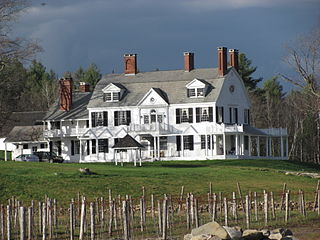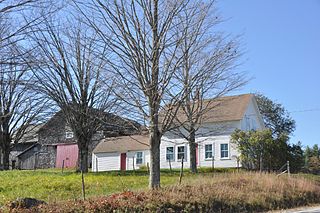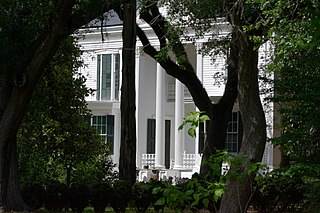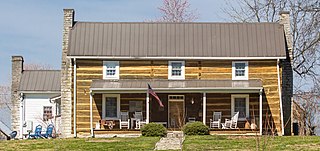Related Research Articles

Horne Creek Farm is a historical farm near Pinnacle, Surry County, North Carolina. The farm is a North Carolina State Historic Site that belongs to the North Carolina Department of Natural and Cultural Resources, and it is operated to depict farm life in the northwest Piedmont area c. 1900. The historic site includes the late 19th century Hauser Farmhouse, which has been furnished to reflect the 1900-1910 era, along with other supporting structures. The farm raised animal breeds that were common in the early 20th century. The site also includes the Southern Heritage Apple Orchard, which preserves about 800 trees of about 400 heritage apple varieties. A visitor center includes exhibits, a gift shop and offices.

Nisbet Homestead Farm, also known as the Old Stone House, is located near the LaSalle County town of Earlville, Illinois. The farm itself is actually in DeKalb County. The homestead is a stone structure, the only one in DeKalb County. The stone house was listed on the National Register of Historic Places (NRHP) on May 31, 1984.

The Alvin T. Smith House is a two-story home on Elm Street in Forest Grove, Oregon, United States. Completed in 1856, it is the second oldest building in the city and was added to the National Register of Historic Places in 1974. A Greek Revival style house, it was built by pioneer Alvin T. Smith beginning in 1854.

Craftsman Farms is a historic house located in Parsippany-Troy Hills, Morris County, New Jersey, United States. It was founded by noted early 20th century designer Gustav Stickley as a farm and school for the Arts and Crafts movement. It remained in use until 1915 when it was sold to a family and became a private house.

The Hermitage near Charles Town, West Virginia is historic property which includes several buildings, as well as non-contributing tennis courts and a pool. The oldest structure is a small stone cottage dating to circa 1734, making it one of the oldest buildings in West Virginia. It resembles Prato Rio in nearby Leetown, West Virginia and may date to this property's first owner, Daniel Barnett, who was a partner in the Burr Iron Works circa 1740, the first of its kind in the state. A stone privy is also believed to be the oldest structure of its kind in the state.
Rose Hill Farm, also known as the James-Marshall-Snyder Farm, is a double-pile, two story brick farmhouse with Greek Revival features near Shepherdstown, West Virginia. A log house on the property was built circa 1795, while the brick house was built around 1835. It is believed that the log house was built by Samuel Davenport, who leased the land from the Stephen family. In 1821 the property was sold to Thomas James.
Hopewell, also known as Hopewell Mills and Hopewell Farm, was established around 1765 by William Little, Sr., who built grain and saw mills near the Shenandoah River. In 1827, William Little, Jr. sold the property to James Hite and Jacob Newcomer. Hite named the property "Hopewell", identifying the mill with a place in Leetown also named Hopewell, where there was a Quaker meeting house. Hite's descendant, Thomas Hite Willis, operated and expanded the mill, adding a woolen mill. The woolen mill operated until the 1920s providing uniforms for the Army.

Scanlon Farm is a late 19th-century loghouse and farm overlooking Three Churches Run east of the unincorporated community of Three Churches, West Virginia. It was listed on the National Register of Historic Places on February 3, 1988.
This is a list of the National Register of Historic Places listings in Williamson County, Tennessee.

The Baldwin-Grantham House, also known as Locust Grove and Shanghai House, was built in 1749 in Shanghai, West Virginia, in the Back Creek district of Berkeley County. The earliest portion of the house is a log cabin built in 1749 by Frances Baldwin. Frances and his wife Sarah lived there until 1790, when they sold the property to Joseph Grantham and Jacob Fry. William Grantham inherited the land from his father and circa 1820 built a brick kitchen addition onto the cabin, which now forms the middle part of the house.

Brook Farm is a historic country estate farm at 4203 Twenty Mile Stream Road in Cavendish, Vermont. It includes one of the state's grandest Colonial Revival mansion houses, and surviving outbuildings of a model farm of the turn of the 20th century. It was listed on the National Register of Historic Places in 1993. The property is now home to the Brook Farm Vineyard.

Greenmead Historical Park, also known as Greenmead Farms, is a 3.2-acre (1.3 ha) historic park located at 38125 Base Line Rd., Livonia, Michigan. It includes the 1841 Greek Revival Simmons House, six other structures contributing to the historic nature of the property, and additional buildings moved from other locations. Greenmead Farms was designated a Michigan State Historic Site in 1971 and listed on the National Register of Historic Places in 1972.

The Crawford-Dorsey House in Lovejoy, Georgia was first begun by William Crawford in circa 1820. The area was then Henry County. Then in the mid-1850s Mr. Stephen Dorsey bought the home. He then moved his home on log rollers to the site of the Crawford home and connected the two homes together to form one residence. In 1858, this part of Henry County became Clayton County. Mr. Dorsey also became a Judge for the county. He was married to Lucinda McConnell.

The John Pope House, also known as Eastview, is a historic house in Burwood, Williamson County, Tennessee. It incorporates hall-parlor plan architecture and single pen architecture.

Buckshoal Farm is a property along with a historic home located near Omega, Halifax County, Virginia. The earliest section was built in the early-19th century, and is the two-story pitched-roof log section of the main residence. The larger two-story, pitched-roof section of the house with its ridge perpendicular to the older section was added in 1841. It features a porch that is configured to follows the shape of the ell and bay of the front of the house. The third two-story addition dates to circa 1910. Also on the property are the contributing log smoke house, well-house and a frame shed. Buckshoal Farm was the birthplace and favorite retreat of Governor William M. Tuck.

The Hersey Farms Historic District of Andover, New Hampshire, includes two farmsteads belonging to members of the Hersey family, located on the Franklin Highway in eastern Andover. The older of the two farms, the Guy Hersey Farm, was established c. 1850 by Hiram Fellows, and has been in the Hersey family since 1904. The adjacent James Hersey Farm was established in 1833 by Alfred Weare, and was acquired by Guy Hersey's son James in 1945. The two farms encompass 325 acres (132 ha), and were listed on the National Register of Historic Places in 2008.

Beech Grove is a historic mansion in Nashville, Tennessee, USA. Built as a log house circa 1850, it was a Southern plantation with African slaves in the Antebellum era. In the 1910s, it became a livestock farm.

Birdsville Plantation, in Birdsville, Jenkins County, Georgia near Millen, is a 50 acres (20 ha) property which was listed on the National Register of Historic Places in 1971. It then included 10 contributing buildings. It is a National Bicentennial Farm.
The Buck Oaks Farm is a historic place founded in 1932 located in Westworth Village, Texas. The house had Colonial Revival styling. It was designed by Earl T. Glasgow, an architect who also designed the Jermyn School and schools in the Fort Worth area.

The Brown-Chenault House, also known as Campbell Farm, is a historic house in Castalian Springs, Tennessee, U.S..
References
- 1 2 3 "National Register Information System". National Register of Historic Places . National Park Service. March 13, 2009.
- 1 2 google book
- ↑ "Historic area farm house moves to preservation site". The Tennessean . September 15, 1993. p. T3F. Retrieved August 29, 2022– via Newspapers.com.